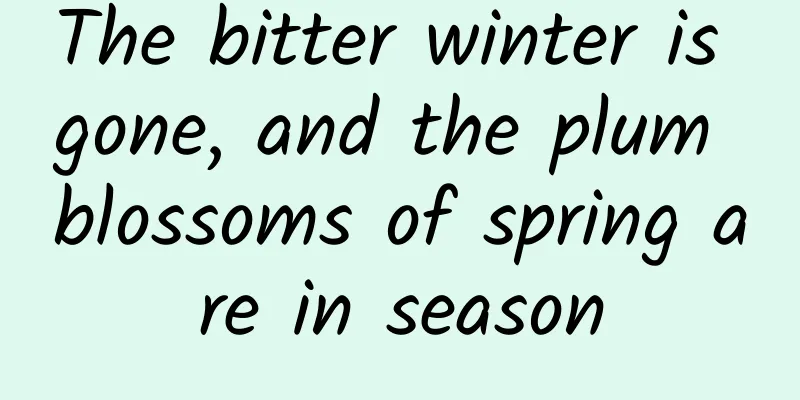The bitter winter is gone, and the plum blossoms of spring are in season

|
Produced by: Science Popularization China Author: Qin Yalong (Institute of Botany, Chinese Academy of Sciences, Jiangsu Province, Nanjing Zhongshan Botanical Garden) Producer: China Science Expo Figure 1: Plum (Image source: provided by the author) Spring will come and go, flowers will fade and bloom again. With the departure of the severe winter cold, the warm spring breeze awakens all things on earth. Under the nourishment of the soft drizzle, the plants gradually reveal their most beautiful faces, decorating the earth and telling people the story of spring. Have you noticed that among all these flowers, there is the graceful figure of plum blossom? Figure 2: Plum (Image source: provided by the author) What kind of plum blossom is the one mentioned in the poem? "A few plum blossoms stand alone in the corner of the wall, defying the cold. I know from afar that it is not snow, because of the subtle fragrance." Wang Anshi's "Plum Blossoms" is a popular poem. The poem uses plum blossoms to express his aspirations, not only describing the plum blossoms that bloom alone in the cold, but also describing his inner loneliness and persistence when he retired to Zhongshan Mountain to be with the plum blossoms. Wang Anshi had a special affection for Zhongshan Mountain, and eventually died in Zhongshan Mountain. He collected more than 300 varieties of plum blossoms on Plum Blossom Mountain in Nanjing Zhongshan Scenic Area, which has now become a popular check-in spot in early spring in the south of the Yangtze River. Back to the poem, whether the plum blossom in the corner is Prunus mume Siebold & Zucc. or Chimonanthus praecox (L.) Link has always been controversial among the people. Some people believe that plum blossoms mostly bloom in early spring, while wintersweets bloom in the cold winter. Combined with the environment described in the poem, this should be wintersweets, and the fragrance of wintersweets is more intense, so you can smell the fragrance of wintersweets from a distance. In addition, the English translation of wintersweets is wintersweet, which literally means sweet flowers blooming in winter, which is enough to show the fragrance of the flowers. Figure 3: Wintersweet (Image source: provided by the author) This statement is true, but it is not scientific. First of all, plum blossoms also have fragrance. When they bloom, the faint fragrance makes people who appreciate the flowers happy. Although compared with wintersweet, the fragrance is slightly lighter, which seems to confirm that it is a subtle fragrance, and the fragrance is not as strong as that of wintersweet. Secondly, plum blossoms are cultivated in many places in my country, mostly in the south, but the flowering period of the plant varies with the region. The plum blossoms distributed in the south of the Yangtze River will bloom earlier the further south you go. In addition, there are many varieties of plum blossoms since ancient times, so naturally there will be plum blossoms that bloom in the twelfth lunar month. It is like "oranges grown in the south of the Huai River are oranges, while those grown in the north of the Huai River are tangerines". Different environments have different growth conditions. Moreover, in ancient times, wintersweet was also called yellow plum and yellow plum blossom. In the postscript to his "Two Poems on Wintersweet" written by Huang Tingjian, a poet of the Song Dynasty, it said: "There is a flower in Beijing and Luoyang, which smells like plum blossoms, has five petals but is not crystal clear, like the wax twisted by women. People in Beijing and Luoyang call it wintersweet...it can make the whole garden fragrant." Li Shizhen, a medical scientist in the Ming Dynasty, wrote in "Compendium of Materia Medica": "Wax plum, also known as yellow plum blossom, is not originally a plum, but because it blooms at the same time as plum, has a similar fragrance, and is colored like beeswax, it got this name." The Qing Dynasty's "Flower Mirror" also wrote: "Wax plum is commonly known as winter plum, also known as yellow plum, is not originally a plum, but because it blooms at the same time as plum, has a similar fragrance, is colored like beeswax, and blooms in the twelfth lunar month, so it has its own name." It can be seen that the plum blossoms that bloom together with wintersweets in the twelfth lunar month have existed since ancient times. The ancients had already distinguished the two. They are not the same kind of plants, but their flowering period, fragrance, flower shape and flower growth method are similar. Moreover, the wax-colored wintersweets should not be mistaken even on snowy days. The plum blossoms written by Wang Anshi are most likely the early-flowering Jiangmei variety. Figure 4: Wintersweet (Image source: provided by the author) Of course, there are many more poems about plum blossoms. "Plum blossoms are three points less white than snow, but snow is less fragrant than plum blossoms." "The cold snow ends in the plum blossoms, and the spring breeze returns to the willows." "Will the winter plum blossoms bloom in front of the beautiful window tomorrow?" "I have no intention of competing for spring, and I will let all the flowers be jealous." "She is not beautiful, but only announces the arrival of spring. When the mountain flowers are in full bloom, she smiles in the bushes." As for whether the poem is about wintersweet or plum blossoms, if you are interested, you can explore the era, region and mood of the author when he wrote the poem and study it carefully. People all over the world love plum blossoms. Since ancient times, they have enjoyed planting, appreciating and writing poems about plum blossoms. So let us explore the "plum" scenery of spring together as the plum blossoms bloom in spring. Figure 5: Wintersweet (Image source: provided by the author) Wintersweet The earliest flowering season is wintersweet. Please note that wintersweet is called plum blossom but not plum. Wintersweet belongs to the genus Chimonanthus of the family Chimonaceae, while plum belongs to the genus Prunus of the family Rosaceae. Moreover, wintersweet is the wax of candles, not the wax of the twelfth lunar month. As mentioned above, the flowers of wintersweet are golden like beeswax and look like plum blossoms. They have bloomed since the twelfth lunar month. In the early spring in the south of the Yangtze River, they can be well connected and blended with plum blossoms, forming a richer "two plum blossoms blooming together" landscape. Figure 6: Wintersweet (Image source: provided by the author) There are many varieties of wintersweets, the most common ones are white-hearted wintersweets, golden bell-shaped wintersweets, dog-toothed wintersweets, bell-shaped wintersweets, small-flowered wintersweets and tiger-hoofed wintersweets. They can also be divided into white-hearted and meat-hearted varieties according to their flower colors. White-hearted flowers are all yellow, while the flower center or petal tip of meat-hearted varieties are purple or reddish brown. Of course, each variety of wintersweets has different ornamental values. As a mature flower-appreciator, I just want to say: I want them all! Figure 7: Plum (Image source: provided by the author) Spring Feast - Plum Blossom In the spring of Jiangnan, plum blossoms of various colors bloom and fill the branches, which is quite spectacular. The calyx of plum blossoms is usually reddish brown, but there are also special ones, such as green calyx plum blossoms. The pedicel of plum blossoms is short and seems to grow close to the pedicel, which is very similar to wintersweets. It is easy to distinguish from cherry blossoms, crabapples, and apricots in the Rosaceae family. Plum blossoms are also a plant that blooms before leaves, with many short stamens and mostly double-petal varieties. Some flowers have a strong fragrance when they bloom. Figure 8: Plum (Image source: provided by the author) Plum blossoms are native to my country and have a cultivation history of more than 3,000 years. They can be used to create landscapes for people to enjoy, or made into bonsai, or multiple plum varieties can be grafted onto the same plant, all of which have extremely high ornamental value. Since 1998, the International Society of Horticultural Science has approved my country's acquisition of the international variety registration rights for plum blossoms. This is the first time that China has obtained international plant registration authority, and it is responsible for issuing an "identity card" to each new plum blossom variety. Figure 9: Plum (Image source: provided by the author) There are many varieties of plum blossoms, which can be divided into true plum, apricot plum and beauty (cherry plum) plum series. Among them, the true plum series can be divided into straight branch plum, weeping branch plum and Longyou plum according to the branch shape; apricot plum is divided into double petals and single petals according to the petals; the beauty plum series has only one variety, "Beauty Plum". Figure 10: Green-calyx plum (Image source: provided by the author) Figure 11: Weeping plum (Image source: provided by the author) Plum blossoms rank first among the "Top Ten Traditional Famous Flowers in China" and are known as the "Oiran". Together with pine and bamboo, they are called the "Three Friends of Winter", and together with orchid, bamboo and chrysanthemum, they are called the "Four Gentlemen". The flowers bloom in early spring, "Ten thousand flowers dare to bloom in the snow, but one tree blooms first in the world", "The sword is sharpened by grinding, and the fragrance of plum blossoms comes from the bitter cold" are all praises of the qualities of plum blossoms, and also explain the characteristics of plum blossoms blooming in late winter and early spring, symbolizing steadfast will and noble character. Figure 12: Apricot plum (Image source: provided by the author) Hybrid among flowers - Apricot plum Prunus mume var. bungo Makino is a natural hybrid of plum and apricot (or wild apricot). Like plum and apricot, it is a plum variety of the genus Prunus in the Rosaceae family. It is also known as foreign plum and European plum. It is a mid-season flowering variety and is often mixed with other varieties of plum in gardens. It serves to connect the flowering periods of mid-season and late-season varieties of plum. It has strong cold resistance and disease resistance, and therefore can be planted in northern regions. The apricot plum is similar to both plum and apricot. It has the characteristics of both apricot and plum. Its branches and leaves are similar to apricot, its pedicels are short, and its fragrance is light, similar to apricot. Its fruit tastes sour, and its pit has small honeycomb-like pits on its surface, similar to plum. As for how to recognize the apricot plum, when we see a plum blossom with its calyx bent back like an apricot, it is probably the apricot plum. Figure 13: Apricot (calyx reflexed) (Image source: provided by the author) Figure 14: Apricot plum (calyx reflexed) (Image source: provided by the author) In the "Plum Blossoms of Fan Village" by the Southern Song poet Fan Chengda, the names, flower shapes, growth patterns and ornamental values of the 12 varieties of plum blossoms in Fan Village were described in detail. Among them, there is also a record about apricot plums: "Apricot plum blossoms are slightly lighter in color than red plum blossoms, and are very firm and colorful. They are all like apricots, but not as good as red plum blossoms." Figure 15: Beauty plum (Image source: provided by the author) The End of Plum Blossoms - Beauty Plum Prunus × blireana 'Meiren' was bred by French scientists in the late 19th century using the double-petaled pink plum as the male parent and the purple-leaf plum (red-leaf plum) Prunus cerasifera 'Atropurpurea' as the female parent. It is also known as cherry plum and is one of the plum varieties with the latest flowering period, from March to April. It has the characteristics of large plum flowers, double petals, and gorgeous colors, as well as the advantages of red-leaf plum, such as dense flowers, purple-red leaves, and dark red twigs. The flowers can be viewed in spring, the leaves in summer, the fruits in autumn, and the branches in winter. Figure 16: Purple-leaf plum (flower) (Image source: provided by the author) Figure 17: Purple-leaf plum (fruit) (Image source: provided by the author) The plum blossoms bloom late, so it can be planted in plum forests to extend the viewing period of plum blossoms. Its flowers are gorgeous, dense, and its leaves are purple-red. It can be planted alone in the courtyard to beautify the landscape, or planted in clusters or along roads to beautify the city. It has great ornamental and application value. Figure 18: Beauty plum (Image source: provided by the author) Some people may ask, has the beauty plum existed in my country since ancient times? Li Yi, a Tang Dynasty poet, wrote "West Hill Late Farewell": "The river flows to the end and I change my horse's fur coat, the beauty under the plum tree leads the wind; the orchid boat is still untied and the red face is tight, the deep resentment is hard to refuse the hairpin and phoenix to stay." From the above we know that the beauty plum was cultivated in modern times through hybrid breeding, and it has only been introduced to China for a few decades, so the beauty plum in the poem should refer to the beauty standing under the plum tree. Figure 19: Beauty plum (Image source: provided by the author) Conclusion Although the plum blossom scenery is beautiful, there are some particular ways to appreciate it. In the Qing Dynasty, Gong Zizhen wrote in "Notes on the Sick Plum Pavilion": "Longpan in Jiangning, Dengyu in Suzhou, and Xixi in Hangzhou all produce plum blossoms. Some people say: Plum blossoms are beautiful because of their curves, otherwise they have no charm; they are beautiful because of their tilts, otherwise they have no scenery; they are beautiful because of their sparseness, otherwise they have no style." The painter Zhang Daqian also pointed out that plum blossoms have four merits: "Rarity is more valuable than abundance; oldness is more valuable than tenderness; thinness is more valuable than fatness; and budding is more valuable than blooming." It can be seen that the beauty of plum blossoms needs to be savored carefully. Whether it is a curved branch, a budding flower, or a sparse branch, when it matches the environment and mood, it can create a beautiful scene. There are many varieties of plum blossoms, and people are constantly cultivating new varieties. For us, we don’t need to be too picky about their specific names. It is enough for us to just recognize the common plum blossom groups, learn how to distinguish them from early spring flowers of the Rosaceae family, and understand some of my country’s profound plum blossom culture. Editor: Sun Chenyu (Note: Latin text should be italicized.) |
<<: How to solve lactose intolerance in milk?
>>: Can't you supplement calcium by sunbathing through glass?
Recommend
Frequency band division of wireless technology for the Internet of Things
Wireless communication technologies all need cert...
Double 11 Douyin e-commerce live broadcast review practical manual
A few days ago, I posted a message on WeChat Mome...
The trouble with the vulgarization of smart TVs: turning users into “fools”
Compared with ten years ago, the functions of sma...
A complete list of Stephen Chow's films on Baidu Cloud, all of Stephen Chow's films on Baidu Cloud!
A complete list of Stephen Chow's films on Ba...
Daytime Research Society C4D Creative Design Course Gray Day - C4D IP Character Binding
File Directory: ├──Information | ├──MAC decompres...
What is the price of 2U server hosting configuration?
The main charging standard for server hosting is ...
Social media is not dead, the high-end game has just begun
Some things, when everyone is pessimistic, actual...
Why do some people feel “bad mentally” during mental health week?
In today's society, mental and psychological ...
Cute little buttons allow you to use mobile apps conveniently
The key to IoT technology is the interconnection ...
Gull-wing doors, king chairs, 5C supercharger, Haobo HT creates a luxurious mobile large flat for elite families
Hyper HT, a medium-to-large luxury pure electric ...
The "COVID-19 Oral Drug" is here! Virus, retreat! Retreat! Retreat!
On July 25, the National Medical Products Adminis...
This Apple Watch-only app can monitor your swimming data
If you like to use smart watches to track your ex...
5 steps to improve product conversion rate!
Double Eleven is coming soon, and many merchants ...
The most practical Tieba traffic diversion methods and techniques on the entire network in 2019!
A large number of account merchants have died thi...
WeChat operation: Master all the skills of WeChat push in 10 minutes!
1. Article Overview Core content: WeChat push ope...









